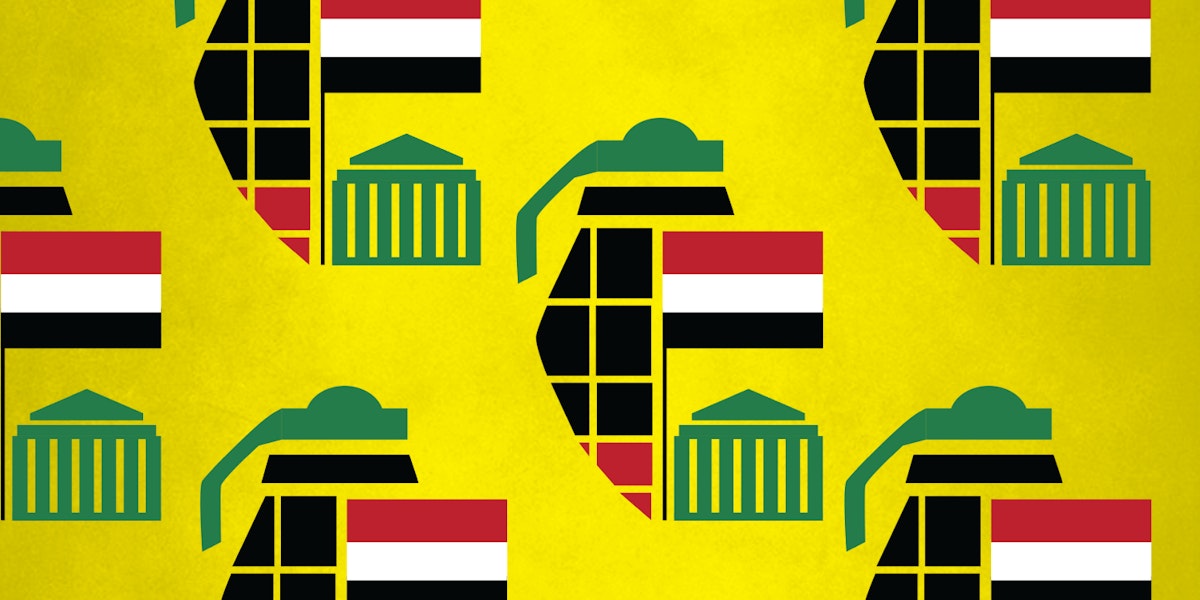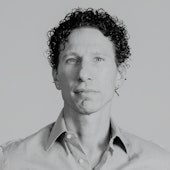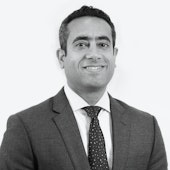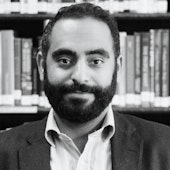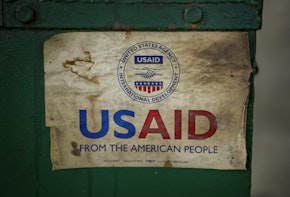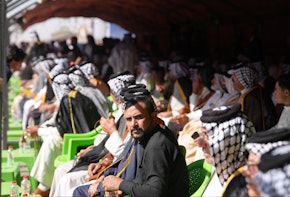Download Hybrid Actors: Armed Groups and State Fragmentation in the Middle East. Click here to learn more or purchase the book.
Executive Summary
The fragmentation of the state in the Middle East and North Africa has become an increasingly urgent topic of study, as so-called nonstate actors have proliferated across the region in the past two decades. From Libya to Lebanon, Syria, Iraq, Yemen, and beyond, countless militias, parties, “brigades,” “forces,” “battalions,” and “detachments” have emerged to directly challenge the formal state’s hegemony over legitimate violence. These groups’ emergence signifies more than simply a region beset by civil conflict and insurgency. It is also the result of a change in the political superstructure. The state is being challenged for its primacy as a political unit.
These new realities of the Middle East have stretched the existing nomenclature to its limits. The term “nonstate actors” is simply too large a basket to hold these diverse types of armed groups. Today, there is a need for more precise terms and categories, for policymakers and for those who study conflict and armed groups. In zones of eroded state authority, armed movements have played a transformative role. Some are simply shadowy arms of the state, even when they are designed to operate as if they were autonomous groups. Others are classic proxies, militias set up by a sponsor government, which operate with a veneer of independence but are in fact wholly controlled by their sponsor and serve their sponsor’s policy aims.
This report is concerned with a third category: the hybrid actor, a type of armed group that sometimes operates in concert with the state and sometimes competes with it. Hybrid actors depend on state sponsorship and benefit from the tools and prerogatives of state power, but at the same time enjoy the flexibility that comes with not being the state. Hybrid actors seek to harness and control some but not all spheres of the state’s authority. Those that survive over many years tend to penetrate the state and carve out official fiefdoms within its architecture. They engage in war, diplomacy, politics, and propaganda. They build and maintain constituencies, providing not just security but also services and ideological guidance. Though almost all hybrid actors have some relationship with an external patron, they are more than mere proxies, and have some latitude to make their own policies and decisions.
This report analyzes hybrid actors along two vectors: their “stateness” (the extent to which they seek to assume state functions) and their autonomy (the degree to which they function as proxies subservient to their patron). Part I develops the concept of the hybrid actor in more detail, situating it in existing theory. Part II presents seven case studies of armed groups and movements: The Popular Mobilization Units (PMU) of Iraq, Hezbollah of Lebanon, the National Defence Forces of Syria, Amal of Lebanon, the Kurdish parties of Iraq, the Iraqi Awakening, and the Islamic State. Some of these cases fully meet the definition of a hybrid actor; others fall short of it, but still exhibit some hybrid traits. Taken together, the case studies flesh out our understanding of the hybrid actor concept. Part III investigates the role of state sponsorship in the creation and evolution of hybrid actors, focusing especially on the case of Iran, which has enjoyed singular success in partnering with such groups. Part IV concludes with recommendations for how policymakers can draw on the hybrid concept to enhance rule of law, incorporate hybrid actors into state and other institutional and legal frameworks, and design more realistic strategies to support weak states in conflict zones.
Hybrid actors have established themselves as an enduring feature of the landscape in the Middle East and North Africa, and may be the single greatest impediment to the reconstitution of state authority. This report seeks to deepen our understanding of such groups and their relationship with weak states—and thus illuminate options for policies that will bring more peace and stability.
Introduction
Decades after their decisive arrival on the scene in the Middle East and North Africa, nonstate actors continue to confound policymakers, diplomats, and analysts. Today, we have clearer definitions and analytical frameworks that allow us to distinguish between nonstate proxy actors, which operate under the control of a sponsor while allowing plausible deniability, and hybrid actors, which develop domestic support by building a local constituency. Both types of actors may attract external sponsorship, usually from a state, and profess a distinct ideological identity. But hybrid actors are distinct in the way that they not only serve a security function, but also play a role in politics and economics—that is, hybrid actors assume some of the functions and autonomy of a state.
Others have produced comprehensive surveys of armed groups and have created taxonomies.1 In this report, we are specifically interested in armed groups that have acquired enduring political and military significance by creating constituencies, while holding territory and engaging in armed conflict. The most important of these groups often capture state institutions and participate, to varying extents, in formal governance. However, these groups also develop structures parallel to the state, affording them extralegal autonomy. These hybrid groups engage in war, diplomacy, politics, propaganda, and constituency building. They are not states as such, and yet they manage long-term relationships with states, and in many cases shape their host states through symbiotic or combative relationships. This report analyzes hybrid actors along two vectors: their “stateness” (the extent to which they seek to assume state functions) and their autonomy (the degree to which they function as proxies subservient to their patron).2
Hybrid actors are powerful but difficult to define; as a result, analysts and policymakers often overlook them or mistakenly consider them to be something they are not, typically a state institution or a classic proxy. The emergence of hybrid actors is a worldwide phenomenon of conflict zones from Colombia to Libya to the Democratic Republic of Congo to Southeast Asia. At the current historical moment, hybrid actors are most prominent in the Levant, an intensely contested region. Several factors have contributed to the vast number of experiments by and with hybrid actors, as defined here, as well as with other proxies and militias: eroded state structures and institutions; open-ended civil and regional wars; sustained interference by competing foreign powers; the resource curse; and the instrumentalization of identity and ideology by local elites. Interventionist powers continue to support nonstate actors and hybrids, sometimes in opposition to states, sometimes as hedges against states that they also support, and at other times as an expedient option to accomplish policy goals. Recent conflicts in Syria, Iraq, Yemen, and Libya all feature foreign intervention on behalf of hybrids—even by governments that also are allied with the state in question. Hybrids thrive where the state is weak and interventionary powers tolerate or even prefer dynamic instability to central authority. At present, Iran is the power most heavily invested in hybrid actors—in part as an ideological function of its revisionist and revolutionary agenda, and in part as a practical function of its limited options for both power projection and state-to-state partnerships in the Middle East and North Africa. Competitor powers in the region, including Israel, the United States, and the Arab states of the Gulf, have all engaged with proxies and hybrids. However, these competitor powers face structural constraints that have limited or undermined their ability to cultivate effective and sustainable partnerships with such groups.
This report identifies some of the key conditions that have made certain hybrid actors successful and persistent, including constituency cultivation, secure relations with their host state, and steady foreign support. Hybrids have assumed geopolitical significance, and are likely to have a wide range of effects across the myriad underlying policy interests that shape the region and its conflicts. If we are to understand the forces at play in conflict zones and design policy responses to those conflicts, we must understand hybrid actors and the ways in which they differ from states and other nonstate actors.
Hybrid actors are pivotal drivers of conflict, insecurity, and the governance challenges that hobble the Middle East and North Africa. In many cases, hybrid actors arose in response to state failures to provide security or services. Today, those same actors, now mature, are a primary obstacle to state efforts to reestablish authority. In this sense, hybrid actors are both a symptom and a driver of state fragility, poor governance, and insecurity.
This report examines cases in Lebanon, Syria, and Iraq because these countries have seen a proliferation of armed groups and disproportionate investment by outside governments. Their conflicts have played host to classic proxies, pretenders to state power, and enduring hybrid actors. A closer look at these cases allows us to pinpoint the distinctions between these categories, and the ways in which some groups evolve along that spectrum. We measure a group’s “success” according to its longevity, influence, and ability to project power militarily as well as politically. We also explore types of autonomy, evaluating the varying abilities of proxy or sponsored groups to deviate from their sponsor’s orders. We believe the evidence from repeated experience with hybrid actors (and comparisons to other types of militias, armed groups, and pretenders to statehood) suggests the conditions that correlate with success for hybrid groups: constituent loyalty; resilient state relationships, including with sponsors; and coherent ideology, in the most compelling examples converging with that of their sponsors. We also believe that descriptive rigor makes it easier to distinguish between hybrid actors (such as Lebanon’s Hezbollah), classic nonstate proxies (such as Iraq’s Kata’eb Hezbollah), and aspirants to statehood that seek to fully destroy the existing state and fashion a radically new one (like the Islamic State). All merit different analytical and policy treatment. This report does not intend to be exhaustive; however, it uses case studies from Iraq, Syria, and Lebanon to present the relationships of actors at three different levels: with their constituents; with their host states; and with the international system, including states and nonstate actors beyond the borders of their host state.
This report concentrates disproportionately on hybrid actors supported by Iran, because such groups currently are preeminent in the region. Such a focus helps us systematically unpack this useful new concept. Compelling cases in Iraq, Syria, and Lebanon allow us to refine the concept of the hybrid actor and show how its various forms can change how policymakers understand armed groups. We believe the hybrid actor concept can be applied to other cases—to groups in Syria like Tahrir al-Sham (formerly known as the Nusra Front) and other Sunni armed opposition groups, and the Kurdish People’s Protection Units (known by its Kurdish initials, the YPG [Yekîneyên Parastina Gel]). It also can be applied to state sponsors of nonstate and hybrid groups, including Turkey, Qatar, Saudi Arabia, and the United States, and to regions beyond the Middle East and North Africa.
The range of examples in these case studies highlight recent relevant facets of hybrid actors. Some illustrate the pathways to establishing successful hybrid groups, and others show the ways in which potential hybrid actors evolve beyond hybridity or fall short of that level. They also present the ways in which consequential nonstate actors fail to meet the criteria for hybridity. In Lebanon, for example, the experience of the political party Amal can be compared to that of Hezbollah. Both groups emerged decades ago as militias, but Amal has grown into being a traditional political actor, whereas Hezbollah has become a true hybrid actor. Although the two groups arose in similar circumstances, their trajectory reflects the variable pressures and influences that can produce distinct results, including moving beyond hybridity and into formalized political life.
This report seeks to illuminate the ways in which influential armed actors can amass power and then project it through, with, and against the weak states in which they arise. Hybrid actors, after all, are not simply proxies or nonstate groups. Understanding their distinctive outside-in approach to the state is critical to understanding power relations within weak states and the ways in which policy responses to them should be formulated.
Table of Contents
Acknowledgments
Executive Summary
Introduction
- The Hybrid Actor Concept
- Case Studies
- The Popular Mobilization Units of Iraq
- Hezbollah of Lebanon
- The National Defence Forces of Syria
- Amal of Lebanon
- The Kurdish Parties of Iraq
- The Iraqi Awakening
- The Islamic State
- State Sponsorship
- Policy Implications
Notes
About the Authors
Notes
- Stanford University’s Armed Group Dataset, for instance, records information about the characteristics of approximately 1,570 armed groups active between 1970 and 2012 and is available at https://web.stanford.edu/~imalone/data.html.
- For a discussion of the principle of stateness, see Francis Fukuyama, “The Missing Dimension of Stateness,” in Francis Fukuyama, State Building. Governance and World Order in the Twenty-First Century (London: Profile Books, 2005) 1–57; and Nehal Bhuta, “Measuring Stateness, Ranking Political Orders: Indexes of State Fragility and State Failure,” EUI Working Papers LAW No. 2012/32 (December 2012), https://ssrn.com/abstract=2201482 or http://dx.doi.org/10.2139/ssrn.2201482.
